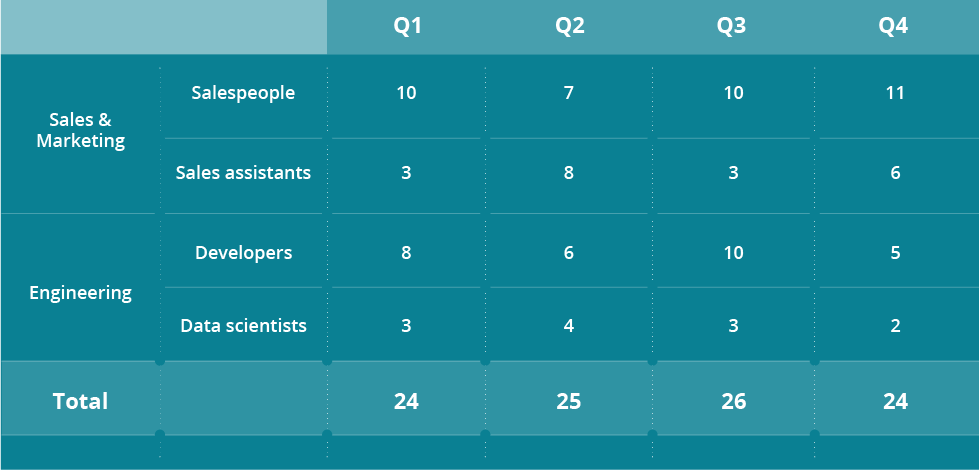How To Create A Recruitment Plan

How to create a recruitment plan:
Revise your job descriptions
Job duties can change over time. Talk to team leaders and ask them how their roles, and their team members' roles, have changed. If your sales team now performs account management, update their job descriptions.
If you don't have formal job descriptions yet, consider conducting a job analysis – a process to determine a job's duties and requirements. Arrange interviews with staff to discuss their roles and responsibilities. You can also use job description templates, a convenient alternative to conducting a job analysis.
Conduct a skills gap analysis
Conducting a skills gap analysis is a systematic way to analyze your staff's current skill level and identify skills you want in the future.
To conduct a skills gap analysis:
- Identify skills you'll need in the future.
- Assess skills your company has already.
- Compare current with desired skills and plan to fill the gaps.
Identify future recruiting needs by talking to senior management and team leaders to understand existing skill levels. Find out how they plan to hit next year's goals. Complement their insights with recent performance reviews or employee surveys. Rate each skill you're looking for on a scale (most commonly a three- or five-point one.)
Prioritize any skills gaps you discover. You can also address gaps by creating training plans for your employees. When skills gaps are too big, consider hiring new people to fill them.
Visualize your hiring activity
A skills gap analysis will provide a general idea of how many new hires you'll need to cover gaps, but there are other ways to predict hiring needs. You can use quantitative methods to forecast future hires in your recruitment plan. For example, companies may set daily sales targets to hit their revenue goals. They can use productivity metrics to find out if their current number of employees can achieve those goals. If not, they can calculate how many more people they need to hire.
Insight from hiring managers can also give you a good estimate of the number of people you need to hire. Schedule meetings with hiring managers to discuss your hiring plan and their staffing needs. Use the information to create a hiring plan spreadsheet with the number of expected new hires per quarter or month. Here's an example:

Hire well in advance of major team or department initiatives, so that your new employees will have enough time to learn their jobs and complete their onboarding period. For example, if your marketing team plans to launch a new campaign in June, fulfill your hiring needs well before then – ideally in the first quarter. Keep your average time-to-fill and time-to-hire in mind. An Applicant Tracking System (ATS) can give you this information automatically.
Revamp your hiring process:
Review your past recruitment plans and hiring habits and ask yourself:
- Did hiring teams communicate well?
- Did hiring processes meet hiring managers' requirements?
- How did new hires perform in their probationary periods?
- What was the new-hire turnover rate (new hires who left in their first three months)?
- Were there any legal issues with hiring processes or candidate experiences? (e.g. consider illegal interview questions and their legal alternatives)
- Are any changes needed to your recruitment or hiring policy?
Answers to these questions will inform the way you hire and how much you'll spend on doing it efficiently. For example, if you find that your hiring teams had problems communicating through email, you could opt for a more user-friendly hiring tool. If managers find that new hires lack some of the skills they expect, explore investing in pre-employment testing.
An improved hiring process begins with effective sourcing. Download our complete sourcing guide for free.
Create a hiring budget
If you have already planned your hiring activity, calculate your cost-per-hire and recruiting yield ratio. Add all internal (for example, referral program incentives and recruiter salaries) and external recruiting costs (for example, agency, job posting and background check fees) and divide the sum by the number of new hires. As part of your personnel budgeting process, forecast the amount you'll pay to your future employees in personnel costs (salaries, benefits and fully burdened costs.)
Think in terms of hiring teams
Your hiring process shouldn't just be efficient for each individual hire. It should build an effective team culture that lasts. Here's how you can attract – and retain – better teams:
- Set diversity targets. Diverse teams perform better than their homogenous counterparts. Incorporate diversity goals into your hiring process and explore partnerships with organizations like Society of Women Engineers and Ascend, a Pan-Asian organization for business professionals in North America.
- Train interviewers. Even experienced interviewers can be biased. Equal Employment Opportunity (EEO) training can help interviewers follow legal guidelines. Vendors like Interview EDGE and The Lou Adler Group can help interviewers develop their skills. HR can also organize in-house training sessions.
- Use processes that reduce biases. Biases are often unconscious. Eliminating them isn't easy, but by tweaking your processes, you can reduce them. Consider using blind hiring and structured interview techniques to reduce hiring biases.
Creating a hiring plan is an opportunity to power up your recruiting and rethink the way you hire. If you aim to hire more objectively and reduce biases, you will build more productive teams and foster a more inclusive company culture.
Learn how you can boost your hiring plan with Workable!
How To Create A Recruitment Plan
Source: https://resources.workable.com/tutorial/develop-recruitment-plan
Posted by: lynnfouty1959.blogspot.com

0 Response to "How To Create A Recruitment Plan"
Post a Comment